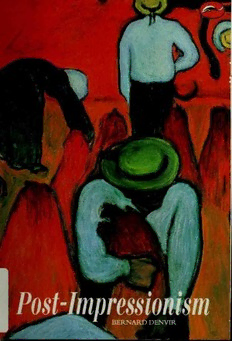
Post-Impressionism PDF
Preview Post-Impressionism
T BERNARD DENVIR f»ft?™zS;«® f tu BOSTON PUBLIC LIBRARY Bernard Denvir is the author ofa four-volume documentary history oftaste in art, architecture and design in Britain, as well as ofbooks on Chardin, Post-Impressionism, fauvism and ofImpressionism: The Painters andthe Paintings (1991). A contributor to manyjournals and magazines, he was head of the Department ofArt History at Ravensbourne College ofArt and Design, a member ofthe Council for National Academic Awards, and forseveral years President ofthe British section ofthe International Association ofArt Critics. His otherbooks include The ImpressionistsatFirstHand (1987), The Encyclopaedia ofImpressionism (1989) and Toulouse-Lautrec (1991), also in the World ofArt series. (J^) WORLD OF ART This famous series provides the widest available range ofillustratedbooks on art in all its aspects. Ifyou would like to receive a complete list oftitles in print please write to: THAMES AND HUDSON 30 Bloomsbury Street, London WCIB 3QP In the United States please write to: THAMES AND HUDSON INC. 500 Fifth Avenue, New York, New York 10110 BERNARD DENVIR Post-Impressionism 148 illustrations, 24 in color T&H Thames and Hudson BRIGHTON Anycopyofthisbookissuedbythepublisherasa paperbackissoldsubjecttotheconditionthatitshallnot bywayoftradeorotherwisebelent, resold, hiredoutor otherwisecirculatedwithoutthepublisher'spriorconsent inanyformofbindingorcoverotherthanthatin which itispublishedandwithoutasimilarcondition includingthese wordsbeingimposedonasubsequentpurchaser. © 1992 ThamesandHudsonLtd, London Firstpublishedin the UnitedStatesin 1QQ2by ThamesandHudson Inc.,300FifthAvenue, New York, New York 10110 LibraryofCongressCatalogCardNumber91-65995 AllRights Reserved. Nopartofthispublicationmaybe reproducedortransmittedin anyformorbyanymeans, electronicormechanical, includingphotocopy, recording oranyotherinformationstorageandretrievalsystem, withoutpriorpermission in writingfrom thepublisher. Printedandboundin Singapore Contents Introduction 7 chapter one A Divided Legacy 11 chapter two The End of an Old World 37 chapter three Discovering New Worlds 73 chapter four AThirstfor Commitment 109 chapter five Words and Symbols 139 chapter six The Discredited Object 171 BIOGRAPHIES 198 SELECT BIBLIOGRAPHY 207 LIST OF ILLUSTRATIONS 209 INDEX 214 POST-IMPRESSIONIST EXPRESSIONS-SKETCHES BY FRANK REYNOLDS. GAZERS AT PAINTINGS FEW APPRECIATE AND FEWER UNDERSTAND: STUDIES AT THE GRAFTON GALLERIES. i 'Post-Impressionist Expressions', IllustratedLondon News 3 December 1910 Introduction The term 'Post-Impressionism' first made its appearance in the summer of 1910 in the course ofa discussion between two English critics, Roger Fry and Desmond MacCarthy, about an exhibition of Frenchpaintingstheywereorganizingtotakeplacelaterintheyearat theGrafton Galleries offBond Street. MacCarthy recordedtheevent thirty-five years later in The Listener: RogerandIandayoungjournalistwhowashelpinguswithpublicitymetto consider this [i.e. a title for the exhibition]. Roger first suggested various terms such as 'Expressionism', which aimed at distinguishing these artists from the Impressionists, but thejournalist wouldn't have that or any ofhis alternatives. AtlastRoger,losingpatience,said'Oh,let'sjustcallthemPost- Impressionists. At any rate, they came after the Impressionists.' The works in the exhibition, which eventually opened on 5 Nov- ember to howls of execration from the press, included over 30 by Gauguin, 20byvanGogh,21 byCezanne, 8 oilsandapastelbyManet and smaller numbers of representative works by Seurat, Signac, Cross, Denis, Serusier, Vallotton, Vlaminck and Picasso. It was what can only be described as a traumatic success, engendering a vast amountofpublicity, emphasizing theemergenceof'modern' art, but polarizing opinions and attitudes about art into a state of confron- tation which was to persist throughout most ofthe century. Virginia Woolf's statement that 'on or about December 1910 human nature changed' was not quite such a hyperbole as it might seem. Sixty-nine years after the Grafton Galleries' exhibition, another one devoted to Post-Impressionism was held in the Royal Academy, London. Itcontained428 paintings drawn fromninecountries. Some idea of how far the stylistic formula invented by Fry had become extended may be derived from the fact that in the French section, in addition to works by those generally accepted as Post-Impressionists, werepaintingsby mainlineImpressionistssuchasRenoir, Monet and Degas, bysocietyportraitistssuch asBesnard andTissotand by genre painters such as Paul Legrand andJean Beraud. The problem of the meaning of Post-Impressionism is com- pounded by the fact that Fry's contribution to the categorization of art history has never won universal acceptance; it is largely confined to the English-speaking world—mainly Britain. Moreover, many of thestylesandmovementsdiscerniblewithintheimplicationsofPost- Impressionism, Symbolism for instance, though they may have had their origin in France, produced some of their most impressive manifestationsoutsidethatcountry. Toattempttocoversomanifesta diversity as that implied by the 1979 Royal Academy exhibition wouldbeimpossibleinaworkofthisscope, andinanycasewouldbe to enlarge the concept ofPost-Impressionism—in reality virtually all developments in art that followed Impressionism, up to Cubism—to
